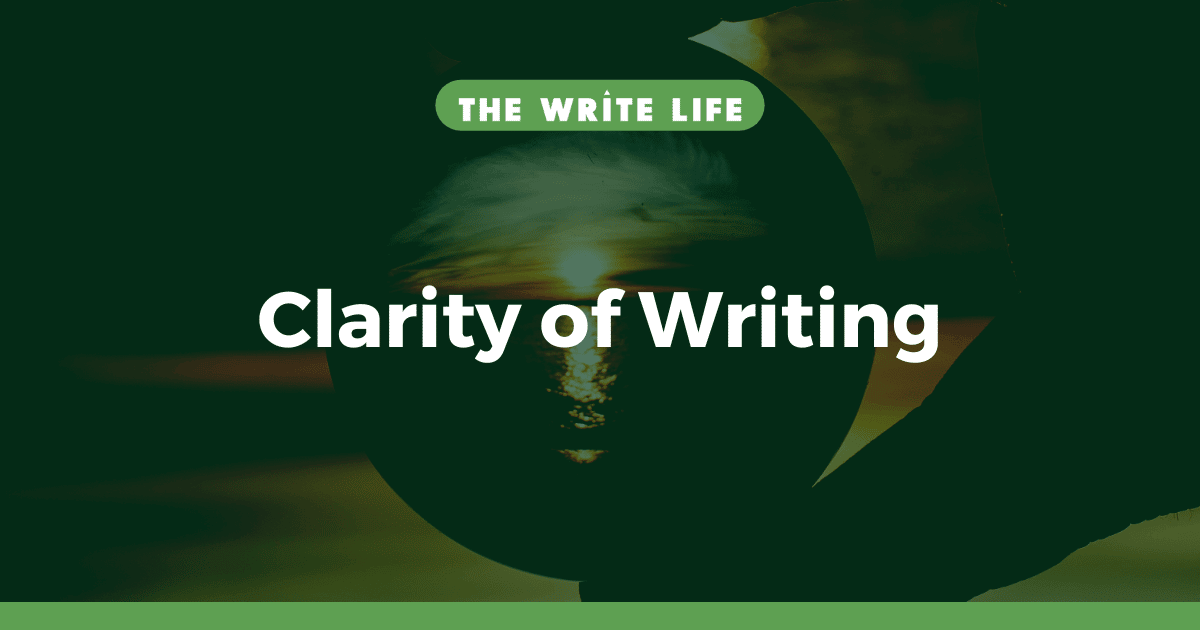While everyone will have their own definition of what good writing looks like, bad writing is more universally recognizable.
If you want to write well, it’s essential to write clearly. Anything else is an absolute disservice to your self-respect as a writer, not to mention the time and attention of your reader.
Sometimes, writers fall into the trap of thinking that if they have an important enough message to share, or an entertaining story to tell, they can get by with not writing clearly. That’s simply not the case. You run a real risk of readers switching off from your work entirely if your writing is unclear.
Let’s explore the concept of clarity of writing as well as nine techniques to attain it.
What is clarity in writing?
Clarity in writing is achieved when your intended meaning is expressed as efficiently as possible.
To understand what clarity in writing looks like, it’s useful to consider its opposite.
When writing is unclear, it causes unnecessary mental effort for your reader. Having to decipher a sentence is not conducive to appreciating or absorbing it.
So what are some of the main impediments to clarity in writing?
- Wordiness. Efficient writers are economical with their words. Saying more with less is a fundamental part of writing well.
- Unstructured text. If sentences, paragraphs, and sections or chapters lack a logical flow, your reader will lose focus. A clear structure is essential for effective writing.
- Inappropriate language. If you use jargon, metaphors, cultural references, or anything else outside of your intended reader’s expectation or understanding, you sacrifice writing clarity.
- Unfocused meaning. Clear writing can only flow from clear thinking. If you’re confused about the point you’re trying to make, or the way you want to express it, you don’t have a chance of writing clearly.
In essence, anything that makes your writing easier to understand and more enjoyable to read is conducive to writing clarity.
Anything that detracts from either objective is undesirable and should be eliminated.
How to achieve clarity in writing – 9 proven techniques
While understanding the concept of clarity in writing is an essential first step to achieving it, it’s not enough on its own.
Instead, if you wish to write more clearly, you need to consciously work at it until it becomes instinctive.
Here are nine techniques to help you achieve greater clarity of writing.
1 – Consistent practice
For most writers, you stand a far better chance of achieving clarity when you write consistently.
If you write on an inconsistent basis, you’ll find the act of crafting a sentence to be laborious and unnatural. It’s like attempting exercise when you are out of shape. Even your best efforts will be far less graceful than someone who trains habitually.
2 – Optimize your writing routine
It’s not enough to write consistently – you also need to optimize your writing space and writing routine.
To produce your best work, you need to find the best combination of conditions for yourself. This is a highly personalized process. One writer’s perfect routine would be another’s poison. Furthermore, your preferences will evolve, so don’t be afraid to experiment with aspects of your writing practice in search of greater clarity.
Some of the factors to experiment with include:
- The location where you write – at home or in public?
- The tool you write with – a simple word processor or something with greater functionality? On a laptop, desktop, or by hand?
- The time of day when you write – when are you at your most productive?
- Do you write with music, white noise, background noise, or as much silence as possible?
- Do you consume coffee while you write? Or even write drunk and edit sober?
Answering these questions and creating a writing routine will make it a lot easier to do your best work.
3 – Outline in as much detail as you need
The extent to which you outline, as well as the type of outline you produce, has a direct impact on the clarity of your writing.
Again, this is highly personal. Some writers find greater clarity by allowing their thoughts to flow freely while they craft. Others find this results in meandering and unfocused text and instead prefer a detailed plan before putting pen to paper.
4 – Find a drafting and editing process that works for you
Typically, most writers will benefit from the advice to write without judgment or hesitation during a first draft and to tighten up on the next round. If you try to achieve perfect clarity on your first attempt at a piece you run the risk of getting caught up in the process of evaluating rather than crafting.
However, some writers report that a quick glance back over a paragraph or section before moving on can be beneficial. Find what works for you.
5 – Clarity is contextual
Clear writing for one readership is likely to look entirely different for another.
For example, if you’re writing for newcomers to a topic, too much jargon is likely to lead to confusion. However, for an expert readership, clarity will require using more advanced terminology, as anything less will seem oversimplified.
Clarity is also partially dependent on genre and style. For example, readers familiar with literary techniques such as metaphor or an unreliable narrator will enjoy and appreciate them. Someone unversed in such techniques may well feel confused.
6 – Read your writing out loud
Different parts of your brain are used when reading something silently in your mind as opposed to reading it out loud.
Something that might seem clear on the page ends up being confusing when spoken. Similarly, your ear will often catch repetition or other impediments to clarity that aren’t apparent when reading silently to yourself.
7 – Use writing tools
Writing apps and tools are no match for a talented human editor. However, they are capable of boosting your writing clarity. Simple, free tools such as Hemingway can easily identify areas of improvement.
For a more detailed analysis of your writing and ways in which it can be improved, consider investing in a paid tool such as ProWritingAid or Grammarly Premium.
8 – Get the right feedback
We all have blindspots as writers. Whether through ego, or oversight, we’re not as capable of objectively evaluating our own text as someone else is.
However, remember that clarity is contextual. Ideally, your feedback will be from someone who fits the profile of your ideal reader. You can also join a writing critique group to improve your writing.
9 – Stay humble and embrace the journey
Perhaps the most important key to achieving clarity of writing is letting go of your ego and being willing to embrace growth.
Even the best writers were not born that way. Achieving consistent clarity is the result of countless hours that we as readers are often not privy to.
Having a sense of humor around your lack of clarity is essential. In ‘On Writing’ Stephen King shares his process of writing a rough draft and then revising it for greater clarity. You will notice that King can laugh at his weaknesses and not take them too seriously.
That’s a Wrap
Ultimately, achieving greater clarity of writing is down to three essential factors:
- Understanding what clear writing looks like and embracing the need to work towards it.
- Consistent and optimal writing practice to improve your level of skill and comfort.
- The right attitude to growing both as a reader and as a writer, and embracing feedback and criticism without getting hurt or frustrated.
Fiction and nonfiction alike suffer when the writer’s intended meaning is distorted by wordiness, confusing sentence structure, inappropriate word choices, and other impediments.
If something is worth writing, it’s worth writing well. Hopefully, by now, that’s clear!



